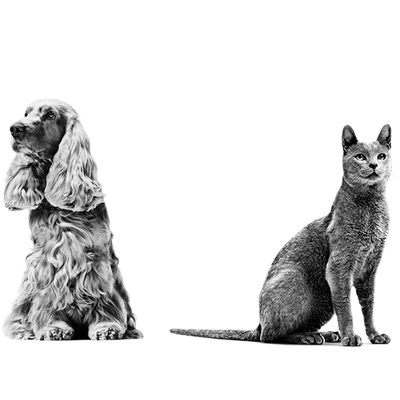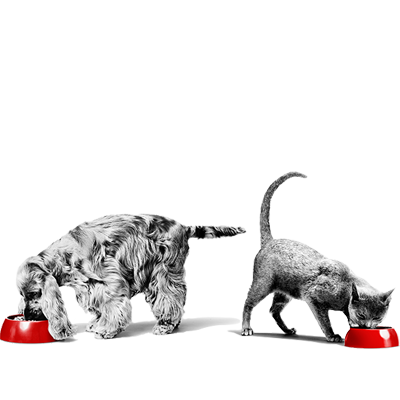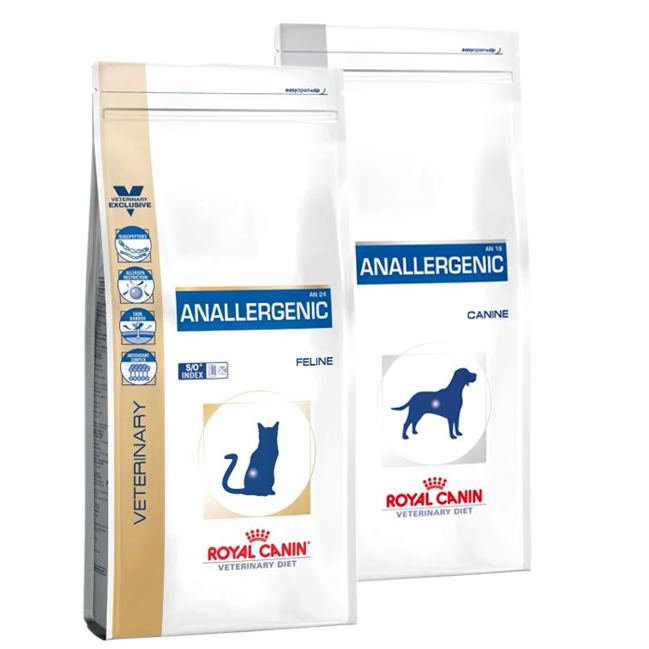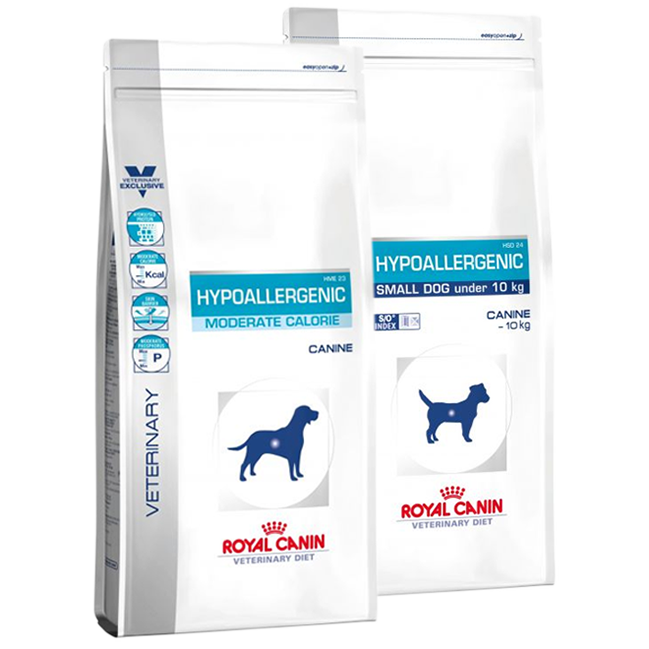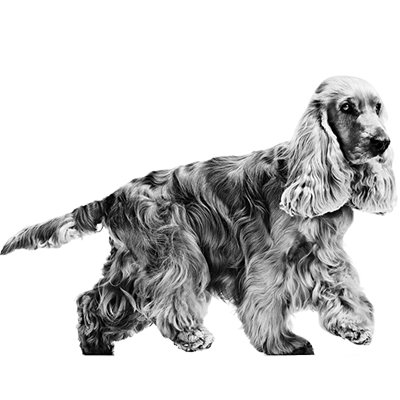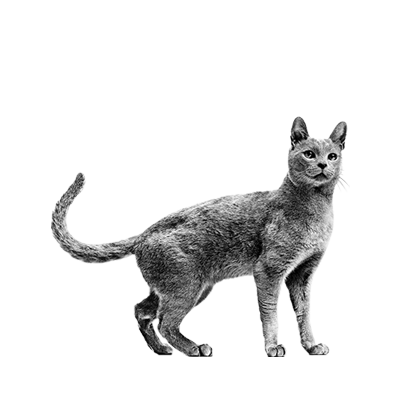Sometimes problem skin is more than a skin problem

Your pet’s coat is made of millions of tiny hairs and the condition of their coat can reflect their overall health.
If your pet starts licking and scratching, it’s time to take notice. What’s happening on the outside may actually be coming from the inside. Scratching could be a sign that your pet is suffering from a dietary intolerance which manifests itself via a range of symptoms, including allergic responses.
Talk to your Vet and discuss whether a tailored diet is required, then ask them to recommend a specific diet from one of ROYAL CANIN®’s leading nutritional ranges.
Below we explain how certain foods cause an allergic response, what the effects of these are, and how a ROYAL CANIN® Veterinary Diet can help.
Anallergenic What causes a food allergy & what are the signs?

Food allergies or adverse reactions to food are harmful responses to an otherwise benign dietary component.
They are specific to an individual animal and signs can be diverse, including primarily skin and gastrointestinal upsets.
It is suggested that many factors such as genetics and environment contribute to the disease, alongside food.
As a response to these reactions, anallergenic diets were developed.
Find out how they help and, if recommended by your vet, how to implement a ROYAL CANIN® diet for your pet.
1. Anallergenic dietary management for pets with food allergies
In some pets, food intolerance is so prevalent that the body will continue to react even to standard hydrolysed protein diets. This is why Anallergenic was developed specifically with this in mind.
Anallergenic contains the smallest possible units of protein, called amino acids and oligopeptides. The unique protein source and production process involved allows for cases of extreme pre-digestion (hydrolysis). Anallergenic also contains purified starch, rather than whole cereals.
2. The recommended diet
A veterinary surgeon would recommend Anallergenic food in the event that they suspect (or have confirmed) that your dog suffers from a nutrient intolerance.
Nutrient intolerance (sometimes referred to as Adverse Food Reactions) is a condition where the body reacts to proteins (allergens) that have been eaten. This is an immune reaction, otherwise known as 'hypersensitivity'.
Recommended diets for the nutritional management of pets with this condition are formulated with ‘protein hydrolysates’. Protein hydrolysis reduces the size of proteins in the food, reducing the risk of the immune system recognising them as an allergen. This pre-digestive step limits the risk of adverse reactions in your dogs.
3. A specific diet for your pet
ROYAL CANIN® Anallergenic includes select ingredients to meet the specific needs of your pet.
Protein is broken down into single or short chains of amino acids called oligopeptides. These very small molecules significantly reduce the risk of a response.
All nutrients and each step of production is strictly controlled to minimise any contamination and maximise diet quality and effectiveness
A patented mix of B-vitamins and amino acids reduce water loss through the skin and help maintain the strong barrier function of the epidermis.
A patented combination of antioxidants work together to help neutralise free radicals.
4. Key features
ROYAL CANIN® Anallergenic is recommended as an aid in the investigation and nutritional management of pets with:
- Nutrient intolerance (including those requiring an elimination diet)
- Dietary intolerance
- Inflammatory bowel disease (IBD)
ROYAL CANIN® Anallergenic diet is enriched in antioxidants (vitamin E, vitamin C, taurine and lutein) to help maintain health and vitality.
'Antioxidant' is a general term for nutrients such as vitamins, minerals and other components naturally present in many foods. Antioxidants neutralise free radicals produced during normal body metabolism that can be detrimental to body cells.
5. Changing your pet’s diet
Normally a change in your pet’s diet should occur over several days. Where a nutrient intolerance is suspected however, the offending food should be removed from your dog’s diet immediately.
In this circumstance, a highly digestible diet such as Anallergenic should be fed without a dietary transition. Nutritional management with Anallergenic may be continued for your dog’s lifetime.
6. How does the elimination diet work?
The First Phase
- Feed ROYAL CANIN® ANALLERGENIC for 6–8 weeks or as directed by your veterinary surgeon
- Over the first seven days, mix an increasing proportion of new food with your pet’s usual food until you have completely switched to the new food
- Keep some of your of pet’s usual food for the second dietary challenge’ phase
- Discontinue all treats, snacks, chews, dental products and toothpaste. Speak to your veterinary surgeon about any flavoured medications and nutritional supplements
The Second Phase
- Once you have completed the elimination diet it is time to challenge your pet by reintroducing their original diet
- Start adding back in a small portion (10-20%) of the original diet mixed in with ANALLERGENIC
- If signs (e.g. itching and scratching) reappear, your vet may confirm your cat or dog has a nutrient intolerance
7. Strict rules for ensuring the best results for your pet
Wash all items used in feeding your pet (including their bowl, feeding scales/cups) with soap and thoroughly rinse all equipment after ever meal.
Have a separate set of feeding equipment reserved just for the affected pet. Feed them separately from other pets and do not leave other pet’s food down between meals to completely avoid snacking from each other’s bowls.
Make sure everyone knows that your pet must not be offered any food other than ANALLERGENIC. That means no snacks, treats or leftovers from the table including vegetables.
For treats, keep a small amount of their daily ration of ANALLERGENIC in a clean, sealed container for rewards..
Keep the bag of Anallergenic sealed between meals and store it in a clean, dry, place. For added protection, you may place the bag inside a sealed container (but do not pour the food out of the bag). Anallergenic was packed in contaminant-free conditions, so keeping it within the bag itself is the best method of storage.
Royal Canin Anallergenic Vet Diet
In some pets, dietary intolerance is so prevalent that the body will continue to react even to standard hydrolysed protein diets.
This is why Anallergenic was developed specifically with these in mind.
ROYAL CANIN® Anallergenic includes select ingredients to meet the specific needs of your pet.
- Protein is broken down into single or short chains of amino acids called oligopeptides.
- These molecules aim to minimise an allergic response.
- All nutrients and each step of production is strictly controlled to minimise any contamination and maximise diet quality and effectiveness.
- A patented complex of select vitamins and amino acids to support the barrier function of the skin
- A patented combination of antioxidants work together to help neutralise free radicals.
Hypoallergenic What causes a food allergy & what are the signs?

Dietary sensitivity and intolerance can manifest in your pet in a number of ways:
- Skin disorders
- Vomiting
- Diarrhoea
Hypoallergenic diets are recommended as an aid in the investigation and management of pets with:
- Dietary sensitivity or allergies to a particular food component
- Dietary intolerance
- Inflammatory bowel disease (IBD)
In such cases, the Royal Canin Hypoallergenic diet presents a low digestive challenge.
Your vet may suggest this diet for your pet – It’s suitable for use in adult dogs and cats, puppies and kittens.
1. Key benefits
ROYAL CANIN® Hypoallergenic diet contains select ingredients to meet the specific needs of your pet. These ingredients include the following:
- Soy protein isolate, which is composed of particularly small proteins, is highly desirable and of very low allergenicity
- A patented mix of B-vitamins and amino acids reduce water losses through the skin and help maintain the strong barrier function of the epidermis
- Omerga-3 fatty acids from fish oils to help support digestive and skin health
- Highly digestible ingredients, prebiotics, fish oils (omega-3 fatty acids), and beet pulp help support the digestive process
Hypoallergenic diets may also have additional benefits
- Hypoallegenic Moderate Calorie's reduced energy content limits weight gain in overweight pets or those with a tendency to gain weight
- A restricted phosphorus intake is beneficial to support renal function with age
- Hypoallergenic Small Dog contains Sodium tripolyphosphate which binds with calcium in salvia, making it unavailable for the formation of tartar
- Low Relative Supersaturation (RSS) diets produce a urinary environment unfavourable to the development of struvite and calcium oxalate crystals
2. The recommended diet
Feeding the right diet is the foundation of managing pets with food sensitivities, intolerances and digestive tract disorders. Everyone who comes into contact with your pet should realise the importance of feeding only the recommended diet – this means avoiding any treats or snacks. It is also important that your pet does not scavenge food elsewhere.
Specially formulated diets, such as ROYAL CANIN® Hypoallergenic, are a very important aid to your pet’s health. They are formulated to minimise the number of potential sources of sensitivity or intolerance. They are lactose-free and wheat gluten-free.
3. Key features
The key features of the ROYAL CANIN® Hypoallergenic diet are:
- Inclusion of low molecular weight (very small) proteins
- Low allergy protein (soy protein isolate)
- Highly digestible
- Lactose-free
- Wheat gluten-free
- Balanced for feeding puppies and kittens
4. Changing your pet’s diet
When an allergic reaction occurs, it’s best to remove the offending foodstuff from your pet’s diet completely, and as quickly as possible.
In all other circumstances, changing your pet’s diet should be carried out over several days according to the following instructions: on day 1, begin by adding a small amount of the new diet to your pet’s existing food. As each day passes, add more of the new diet to your pet’s existing food. As each day passes, add more of the new diet to less of the original food, until eventually you are only feeding the new diet. This change should take around 5-7 days.
5. Answers to your questions
My pet is affected by 'acute diarrhoea', what does this mean?
Your pet is affected by acute diarrhoea when the normal digestive processes are disturbed. Water and nutrients are not efficiently absorbed from the intestine into the body; this results in large volumes of diarrhoea. Pets with diarrhoea are at risk of becoming dehydrated due to this loss of fluid. Vomiting, if present, results in even more fluid loss.
Your veterinary surgeon will advise you when to begin to feed ROYAL CANIN® Hypoallergenic Diet. This highly digestible, ‘bland’ diet allows the intestine to easily digest and absorb the essential nutrients needed by your dog or cat.
Why does my pet’s diet contain a specific source of protein?
ROYAL CANIN® Hypoallergenic is a highly digestible diet in which the protein content is:
- Soy protein of high nutritional value
- 'Pre-digested' or 'hydrolysed' and extremely unlikely to cause a reaction
When proteins are hydrolysed they are broken down into small pieces that are unrecognisable to the body – this also increases their digestibility.
Royal Canin Hypoallergenic Vet Diet
ROYAL CANIN® Hypoallergenic diets offer a highly palatable complete diet for nutritional support of pets with dietary sensitivities and intolerance's and include select ingredients to meet the specific needs of your pet.
- Hydrolysed proteins are proteins that have been broken down into smaller components to create a diet that is highly digestible and less likely to cause an allergic response.
- A patented complex of select vitamins and amino acids to support the barrier function of the skin
- Essential Fatty Acids EPA/DHA to help maintain a healthy digestive system and a healthy skin.
- Highly digestible ingredients, prebiotics, fish oils (omega-3 fatty acids), and beet pulp help support the digestive process.
Skin Care How can Royal Canin help with Skin Care?

If your dog has been diagnosed with Dermatosis, a diet based on highly digestible wheat gluten and rice, such as ROYAL CANIN® Skin Care, may be recommended by your Vet to give both short and long term nutritional support. Discover the features and benefits a ROYAL CANIN® Skin Care diet can bring, plus answers to commonly asked questions.
1. Key benefits
ROYAL CANIN® Skin Care contains select ingredients to meet the specific needs of your pet and help support the skin’s natural defences:
- A blend of fatty acids help in the nutritional support of dogs skin
- A patented mix of B-vitamins and amino acids reduce water losses through the skin and help maintain the strong barrier function of the epidermis
ROYAL CANIN® Skin Care diets may also have additional benefits:
- A patented combination of antioxidants work together to help neutralise free radicals
- The synergistic antioxidant complex along with fermentable fibres (MOS) help support developing natural defences
- Highly digestible protein, prebiotics, fish oils (omega-3 fatty acids) and beet pulp help support the digestive process
- Skin Care Small Dog kibble has a cleaning action on the tooth surface and sodium tripolyphosphates bind salivary calcium making it unavailable for tartar formation
2. The recommended diet
Feeding a specifically formulated diet can often help support dogs with dermatosis. Everyone who comes into contact with your dog should realise the importance of feeding only the recommended diet.
Skin Care is formulated to have great positive benefits when fed exclusively – mixed feeding (including the feeding of treats or snacks) is not recommended. To maximise diet benefits, divide your dog’s daily allowance into at least two meals. Fresh drinking water should be available to your pet at all times.
3. Key features
ROYAL CANIN® Skin Care offers a highly palatable completely diet for nutritional support of dogs with dermatosis, with the benefit of:
- Combined essential fatty acids from linseed, soya, borage and fish oils
- Complex of select vitamins and an amino acid which supports the barrier function of the skin
- High digestibility and palatability
- Antioxidants (vitamin E, vitamin C, taurine and lutein) to help maintain health and vitality.
4. Changing your pet’s diet
Changing your pet’s diet should always be carried out over several days. It is not uncommon for pets to refuse a new diet or to suffer from stomach upsets if the change is not gradual.
On day 1, begin by adding a small amount of the new diet to your pet’s existing food. As each day passes, add more of the new diet to your pet’s existing food. As each day passes, add more of the new diet to less of the original food, until eventually you are only feeding the new diet. This change should take around 5-7 days.
5. Answers to your questions
My dog has been diagnosed with atopy, what does this mean?
Atopy – or Canine Atopic Dermatitis – is the term used for allergic skin disorders in dogs. Atopy is thought to result from an abnormality in the immune system of affected dogs as well as defects in the skin barrier function such that intense reactions occur to external irritants. Itching and redness can occur anywhere on the dog but is most commonly seen on the paws, face, ears and skin creases. Your dog may chew and bite at their skin causing hair loss and in some cases secondary infections.
Speak to your veterinary surgeon for further advice
Can I use ROYAL CANIN® Skin Care in conjunction with medications?
Your veterinary surgeon may recommend medication such as antibiotics, steroids or cyclosporins. ROYAL CANIN® Skin Care is not an alternative to medication but is often recommended by your Veterinary Surgeon to help support the skin function.
How long will it take before I see any benefit to my dog?
Considering the Skin Care diet reinforces the natural skin barrier, effects should usually be seen after one skin renewal cycle (22-30 days). It is recommended that Skin Care is fed for a minimum of two months for full benefits.
How long should I continue to feed ROYAL CANIN® Skin Care?
In acute cases, such as nutritional support for skin healing, burns and wounds, Skin Care may be fed until the condition is resolved. Many skin conditions are recurrent however and so long term or life time nutritional support with Skin Care is recommended.
What is the difference between the different types of Skin Care Diets?
The Skin Care Junior Small Dog and Skin Care Small Dog products take the nutritional requirements of these select groups into account. The formula and kibble design of these diets are adapted in recognition of the fact that young dogs should be fed differently to mature dogs and small dogs have different requirements to larger dogs.
How does Skin Care Small Dog support the dental health of dogs?
With a greater risk of dental disease, small dogs are supported with a kibble size and texture which encourages crunching plus active ingredients. These trap salivary calcium, making it less available for tartar formation.
What else can I do to help my dog?
As dermatosis can affect your dog throughout their life, be sure to do all you can to remove other potential skin irritants; maintain strict flea control, wash bedding with an appropriate washing agent and vacuum your pet’s living area regularly in addition to following your Veterinary Surgeon’s recommendations.
Royal Canin Vet Diet Skin Care
Feeding a specifically formulated diet can often help support dogs with dermatosis.
ROYAL CANIN® Skin Care offers a highly palatable complete diet and can be used for short and long term nutritional support of dogs with dermatosis and includes select ingredients to meet the specific needs of your pet.
- Essential Fatty acids, EPA & DHA, help maintain a healthy digestive system and a healthy skin.
- A patented complex of select vitamins and amino acids to support the barrier function of the skin
- High digestibility and palatability
- A patented synergistic complex of antioxidants to help support natural defences.
 If you are ever concerned about your pet, seek immediate advice from your vet.
If you are ever concerned about your pet, seek immediate advice from your vet.

 Exemplary Customer Service
Exemplary Customer Service